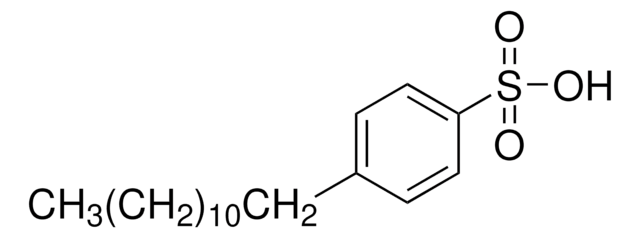09887
Ammonium lauryl sulfate solution
~30% in H2O (T)
Synonym(s):
Ammonium dodecyl sulfate, Dodecyl sulfate ammonium salt
About This Item
Recommended Products
description
anionic
Quality Level
form
liquid
mol wt
283.43 g/mol
concentration
~30% in H2O (T)
color
Colorless to Very Light Yellow and Colorless to Very Light Green-Yellow
refractive index
n20/D 1.37
pH
6.8
solubility
water: soluble at 20 °C
density
1.02 g/mL at 20 °C
application(s)
cleaning products
storage temp.
15-25°C
SMILES string
N.CCCCCCCCCCCCOS(O)(=O)=O
InChI
1S/C12H26O4S.H3N/c1-2-3-4-5-6-7-8-9-10-11-12-16-17(13,14)15;/h2-12H2,1H3,(H,13,14,15);1H3
InChI key
BTBJBAZGXNKLQC-UHFFFAOYSA-N
Looking for similar products? Visit Product Comparison Guide
General description
Application
- A catalyst in the synthesis of 1H-benzo[d]imidazole, quinoxaline, and 2,3-dihydro-1H-benzo[b][1,4]diazepine derivatives by reacting with benzene-1,2 diamine and aromatic aldehydes/1,2-diketones/ketones respectively.
- A corrosion inhibitor for carbon steel and copper in acidic solution.
- A surfactant in the fabrication of porous ceramics by gel casting.
Signal Word
Warning
Hazard Statements
Precautionary Statements
Hazard Classifications
Aquatic Chronic 3 - Eye Irrit. 2 - Skin Irrit. 2
Storage Class Code
10 - Combustible liquids
WGK
WGK 3
Flash Point(F)
Not applicable
Flash Point(C)
Not applicable
Regulatory Listings
Regulatory Listings are mainly provided for chemical products. Only limited information can be provided here for non-chemical products. No entry means none of the components are listed. It is the user’s obligation to ensure the safe and legal use of the product.
PRTR
Class I Designated Chemical Substances
ISHL Indicated Name
Substances Subject to be Indicated Names
ISHL Notified Names
Substances Subject to be Notified Names
JAN Code
09887-VAR:
09887-250ML:
09887-BULK:
09887-1L:
Choose from one of the most recent versions:
Already Own This Product?
Find documentation for the products that you have recently purchased in the Document Library.
Our team of scientists has experience in all areas of research including Life Science, Material Science, Chemical Synthesis, Chromatography, Analytical and many others.
Contact Technical Service







